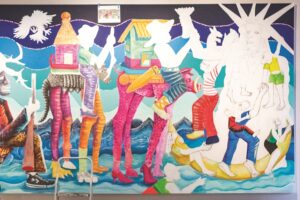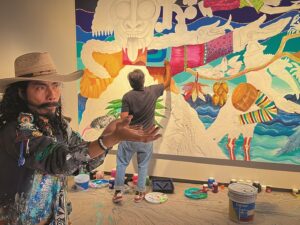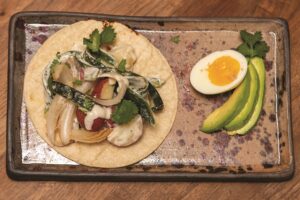I knew a winter trip to Mexico City would be a chance to improve my rusty Spanish and eat (a lot). This time I also found myself learning about art.
Mexico City jockeys for the laudable position of being the city with the most museums in the world. One of these, San Ildefonso, a gorgeous former Jesuit boarding school, is the birthplace of Mexican muralism. On its walls are works by José Clemente Orozco and Diego Rivera, who along with David Alfaro Siqueiros are known as Los Tres Grandes of the movement.
Orozco’s somber political murals, which ring the open courtyards and stairways of the building, shook loose a first odd food-and-art connection: during my freshman year at Pomona College, Orozco’s 1930 fresco of a colossal naked Prometheus had looked down at me through every meal.

In a side gallery at San Ildefonso, Robert and I were entranced by another mural, this one a contemporary work-in-progress. It covered two long walls with dreamlike creatures and flying backpacked humans in rich azures, vibrant pinks, and a fiery orange. Called The Death of Cultures (black Mexico), it is by the Guerrero painter Baltazar Castellano Melo, in collaboration with Olga Manzano and José Luis Hernández Guzmán. The three are members of Raíz de la Ceiba, an art collective focused on Afromexicano culture.
Castellano welcomed us into the collective’s open studio. The mural, he told us, is about migration and memory — the psychic and tangible losses of Mexican identity that migrants experience and the tensions felt by both those who stay and those who leave. The canvas is anchored on one end by a huge Guerrerense masked figure surrounded by iguanas and roosters and on the other by the Statue of Liberty — America’s Virgen de Guadalupe, he calls her — who has mothers and children clinging to her. Between the icons are bundles of corn, chiles, mangos, coffee, and cacao pods.
The mural sends my thoughts from the studio to the street. The foods in the mural are so much a part of Mexican identity. And they are all on view in the neighborhood where we are staying. Exploring it is like walking through an open kitchen, with food prep happening all around — everywhere someone is peeling fragrant mangos, or dicing potatoes, or cutting juicy limes. The air is seasoned with the sizzling scent of onions mixing with spicy chorizo and waves of charcoal smoke.

Women pat out blue corn masa into ovals, then stuff them with favas or black beans and cheese for tlacoyos. I could watch them all day; their delicate gestures are mesmerizing as they gracefully place the tlacoyos on the hot comal next to gorditas, quesadillas, and tortillas. Unfazed by the heat, the cooks scoot and flip their denim-blue masa creations by hand.
Full props go to the carnitas guy on the corner and the street kitchen he sets up daily. He braises hunks of pork in what resembles an oversized metal wash tub. Then, under the shade of a floral umbrella on a collapsible table, he whacks his cleaver through the tender meat that rests on a worn trench in his cutting board. He scoops up the meat with double-thick warm tortillas, finishes the taco with a cascade of minced cilantro and white onion, and hands it over with a smile that says, “Esto sí que es bueno.” Eaters hang out, have a taco, then go back for seconds.
Chilangos — what Mexico City locals call themselves — love carbs: corn, rice, beans, and potatoes, in combination or on their own, are ubiquitous taco fillings. But one taco that I can’t get out of my head was a fresh tortilla folded around chile-spiced potatoes, fresh fava beans, guacamole, and nopales (cactus), and topped with bits of pork rind crisp-fried into chicharrones. Maybe it was because we ate it under a highway next to a pulque vendor’s spot (pulque is a fermented drink something like a Mexican kombucha) but it seemed to me to be everything a taco can be.

To hold these flavor-memories I filled my suitcase with jars of mole, salsa macha, and dried chiles. Still, I like knowing that back in Wellfleet, even after I have run through all these supplies, I can still make one of my favorite tacos: papas con rajas. This is a tortilla folded around potatoes with blistered poblano chile strips and white onion. I love this as a breakfast taco with eggs, or paired with wilted Swiss chard or spinach, or combined with strips of roast chicken.
If you don’t find Mexican-style crema at your grocery store, crème fraîche is a fine substitute — it will simmer without curdling. I usually turn to Serious Eats for a reminder on how to make it myself out of cream spiked with buttermilk and left on the counter overnight.
Tacos de Papas con Rajas
Serves 4
½ lb. waxy potatoes, small red-skinned or Yukon gold
Kosher salt
2 or 3 medium poblano chiles
1 Tbsp. unsalted butter or mild-flavored oil or a combination
½ white onion, thinly sliced
¾ cup crema (or crème fraîche)
8 or more corn tortillas
Chopped cilantro to taste
- Quarter the potatoes if using red-skinned, or peel and dice the Yukon golds. Put the potatoes in a pot with water to cover and season generously with salt. Bring to a boil and then lower the heat to maintain a gentle simmer. Cook until potatoes are fork-tender, 3 to 5 minutes. Drain.
- Meanwhile, char the poblanos over an open flame or under the broiler, turning until their skins blacken, 5 to 10 minutes. Transfer chiles to a bowl and cover with a plate or pan lid to steam and cool. Rub or rinse the skin off the poblanos, then seed and cut into thin strips.
- Warm the butter or oil in a skillet over medium heat, add the onion, season with salt, and cook, stirring occasionally until wilted, about 5 minutes. Add the potatoes and chiles and the crema. Season to taste with salt. Bring to a simmer, stirring gently, then remove from the heat, cover, and set aside while you heat the tortilla. (If the mixture gets really tight, or if you’re reheating it, just add a splash of water.)
- Warm the tortillas, either wrapped in a moist towel in a microwave or in foil in a 300° F oven. Tuck the potatoes and chile filling into the warm tortillas and top with cilantro.



